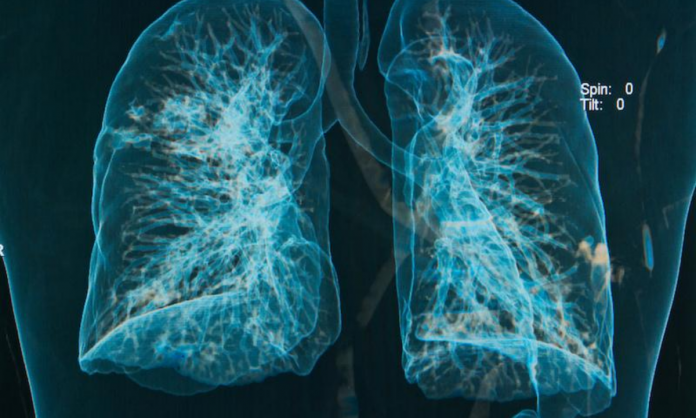Silica is often called “the new asbestos”. But Ryan Hoy, a respiratory specialist with a practice in occupational lung disease, doesn’t like the comparison. He points out, in a joint investigation by 9News and the Sydney Morning Herald into the new wave of silicosis, that the disease is not new. It’s one of the oldest occupational lung diseases in the world.
Ominously, sufferers of silicosis are younger than most people who succumb to mesothelioma, the form of cancer caused by asbestos exposure. People in their prime quickly progress from getting breathless going up stairs to being unable to play sport or play with their kids. Some are given just months or a few short years to live. Others eligible for a lung transplant may have their life extended by a decade or more, but it is not curative.
The comparison with asbestos is compelling in other ways. Workers who cut through asbestos products in decades past describe how it generated clouds of dust, similar to today’s masons dry-cutting and polishing engineered stone in small workshops.
Back then, the knowledge that asbestos was dangerous was only just starting to get out to the community. In large measure, that was thanks to unions. First, they demanded extra payment for workers handling it, and through the 1970s there were more questions about its safety and demands for respirators and training. The bosses fobbed them off.
Union campaigning is the reason so many now know that asbestos is dangerous—even if they don’t fully understand how even small exposures pose a risk. In 2002, James Hardie, Australia’s largest manufacturer of asbestos-containing materials, tried to move its business to the Netherlands to avoid its full liabilities to asbestos-disease sufferers. The Australian Council of Trade Unions and Bernie Banton, a former shop steward at James Hardie’s Camelia plant in western Sydney, who developed asbestosis and then mesothelioma, launched a campaign to force the federal and state governments to intervene to ensure there would be sufficient funds to satisfy asbestos claims in the future.
Today, unions are calling for a ban on the importation of engineered stone, the product used to make a popular type of kitchen benchtop that can contain up to 95 percent silica, which exposes so many stonemasons to disease. Unions have taken up the fight over the last few years, running awareness campaigns among members and in the media. The media spotlight on the issue dovetails with their efforts to pressure the new Labor government to accelerate action on the issue as it considers the recommendations of a Safe Work Australia report.
In response, Workplace Relations Minister Tony Burke convened a meeting with state health ministers. After Burke saying, “I am not willing to wait” to alter the workplace protections for workers exposed to silica dust, the meeting agreed to wait another six months to decide whether a ban on the importation of engineered stone products was necessary to allow Safe Work to prepare another report. This is a small acceleration of the timeline adopted by the previous Liberal government, based on a 2018 Safe Work report that recommended a ban be considered in July 2024 if there were not improvements to safety in workplaces using the product in the meantime.
Anthony Albanese justified the delay based on the need to avoid “unintended consequences”, which we can presume means a hit to business profits. The Business Council of Australia complains that banning engineered stone will stifle innovation, baulking at safety concerns it considers to be a constraint on the development of new and potentially profitable products.
The report also recommends that the permitted level of exposure to silica dust be halved in jurisdictions that have not done so already. This would still be double the levels allowed in the United States and recommended by the Cancer Council and the Lung Foundation. There is no known safe level of exposure.
Ultimately, for workplace health and safety laws to be effective, they must be enforced. Enforcement is particularly important in the stone benchtop industry, which is full of small businesses that employ a handful of workers each and rely on them not understanding either their workplace rights or the dangers of silica exposure. One of the most alarming revelations in the recent media investigation was that WorkSafe NSW and WorkSafe Victoria did not send inspectors to some sites when they received tip-offs. Instead, they sent a letter to the employer informing them that they received a tip-off but had decided no-one would attend.
Even where there are requirements to monitor dust levels, the report highlighted examples of large employers like John Holland manipulating the system by sending workers to the least dusty parts of the site to record measurements, and obstructing union officials attending the site to take their own measurements. This problem is made worse by restrictions on unions entering workplaces. Self-monitoring of dust levels is notoriously unreliable. Even James Hardie and Wunderlich agreed to dust monitoring at their asbestos factories.
Facing the prospect of a total ban on the importation of their products, Caesarstone and Cosentino are advocating for a limit of 40 percent silica content in engineered stone. Lowering the silica content would lengthen the period over which a worker would need to be exposed to breathe in concentrations of silica capable of causing disease, but there is an absence of research confirming what is a safe level of exposure. A spokesperson for Cosentino reportedly gave an assurance, however, that there would be no price increase for the new product, so no change to operators’ profit margins.
Here there are also parallels with the response of big business to the dangers of asbestos: deny, then minimise and manipulate public health authorities to stave off change for as long as possible.
The companies that manufactured asbestos products had known about the dangers for decades before phasing out asbestos products in the 1980s. When it was clear that there would be strengthened regulations, the companies ensured that their representatives participated in public health authorities to attempt to shape the response and assure governments that they had already implemented adequate changes in their industry.











